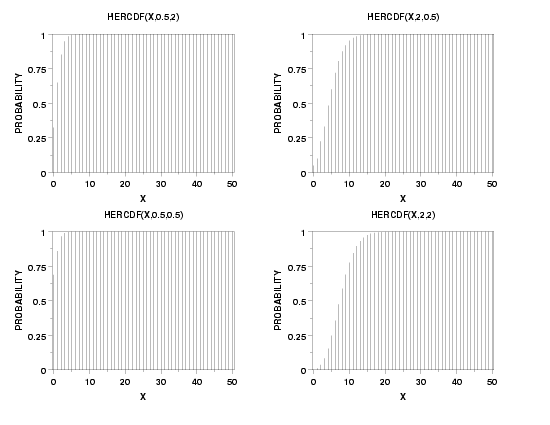

|
HERCDFName:

 and
(1/2) and
(1/2) 2,
respectively, then X1 +
2X2 follows a Hermite distribution
with shape parameters 2,
respectively, then X1 +
2X2 follows a Hermite distribution
with shape parameters
 and and
 . .
Some sources in the literature use the parameterization


b = a2 = 0.5  2 2
The shape parameters

The probability mass function for the Hermite distribution is:

where
with
![H*(x)(beta) = SUM[j=0 to INT(N/2)][N!*X**(N-2*j)/((N-2(j)!j!2**j)]](eqns/herpoly.gif)
with [n/2] denoting the integer part of (n/2). The first few terms of the Hermite probability mass function are:
![p[x=0] = EXP[-alpha*beta - alpha**2/2]](eqns/herpdf0.gif)
A general recuurence relation is:
![p[X=x+1] = (1/(x+1))*(alpha*beta*p[X=x] + alpha**2*p[X=x-1])](eqns/herrecur.gif)
For x < 26, Dataplot uses the above recurrence relation to compute the probabilities. For x > 25, Dataplot uses an asymptotic formula due to Patel (see Reference section below) to compute the probabilities.
where <x> is a non-negative integer variable, number, or parameter; <alpha> is a number or parameter that specifies the first shape parameter; <beta> is a number or parameter that specifies the second shape parameter; <y> is a variable or a parameter (depending on what <x> is) where the computed Hermite cdf value is stored; and where the <SUBSET/EXCEPT/FOR qualification> is optional.
LET X2 = HERCDF(X1,ALPHA,BETA) PLOT HERCDF(X,0.8,1.4) FOR X = 0 1 20
"An Asymptotic Expression for Cumulative Sum of Probabilities of the Hermite Distribution", Y. C. Patel, Communications in Statistics--Theory and Methods, 14, pp. 2233-2241. "Some Properties of the Hermite Distribution", Kemp and Kemp, Biometrika (1965), 52, 3 and 4, P. 381. "Even Point Estimation and Moment Estimation in Hermite Distributions", Y. C. Patel, Biometrics, 32, December, 1976, pp. 865-873.
MULTIPLOT 2 2
MULTIPLOT CORNER COORDINATES 0 0 100 100
XTIC OFFSET 0.5 0.5
LINE BLANK
SPIKE ON
TITLE AUTOMATIC
X1LABEL X
Y1LABEL PROBABILITY
X1LABEL DISPLACEMENT 12
Y1LABEL DISPLACEMENT 12
TITLE SIZE 3
PLOT HERCDF(X,0.5,2) FOR X = 0 1 50
PLOT HERCDF(X,2,0.5) FOR X = 0 1 50
PLOT HERCDF(X,0.5,0.5) FOR X = 0 1 50
PLOT HERCDF(X,2,2) FOR X = 0 1 50
END OF MULTIPLOT

Date created: 7/7/2004 |